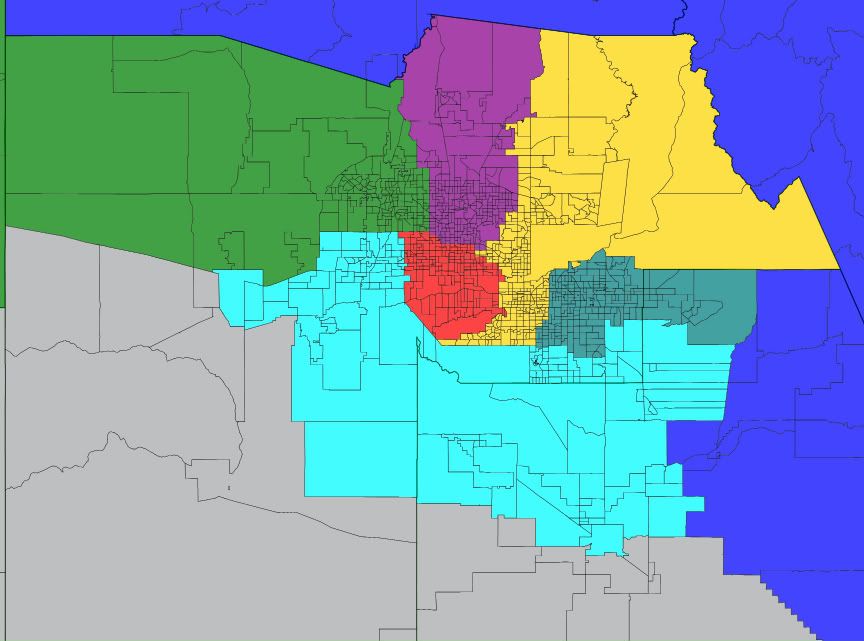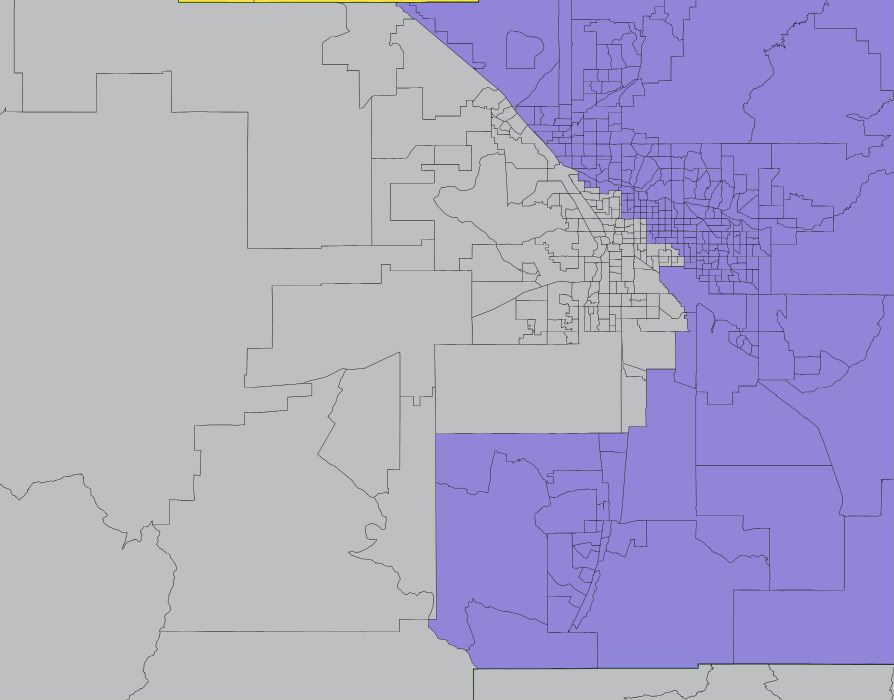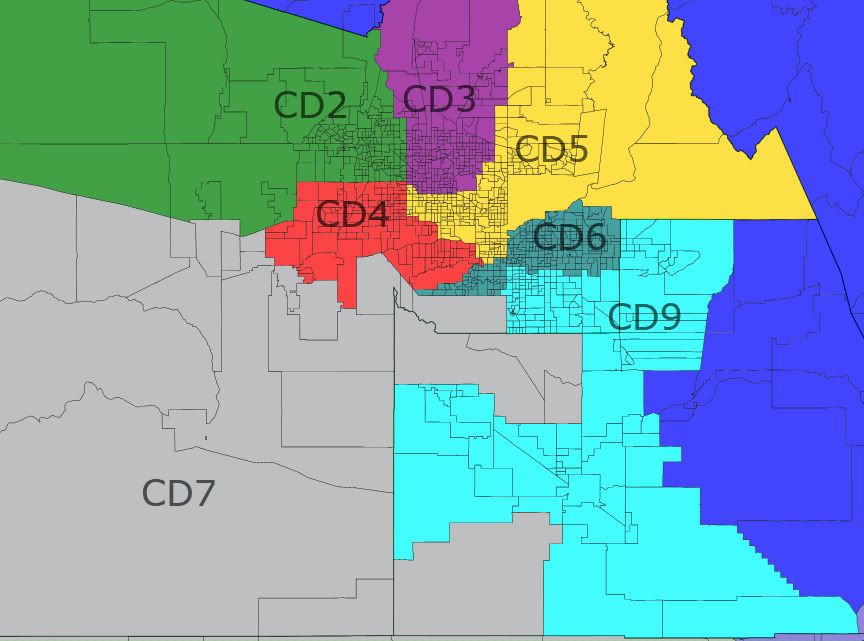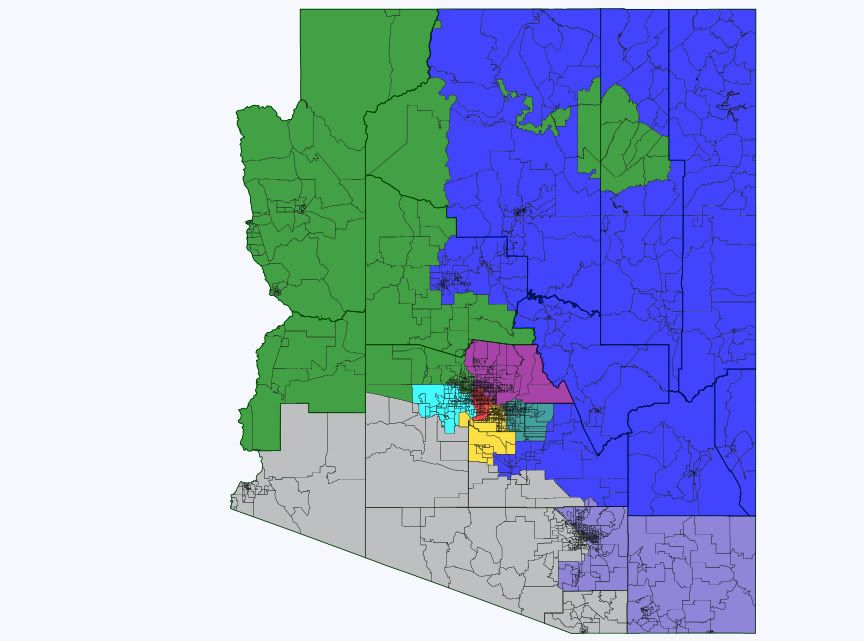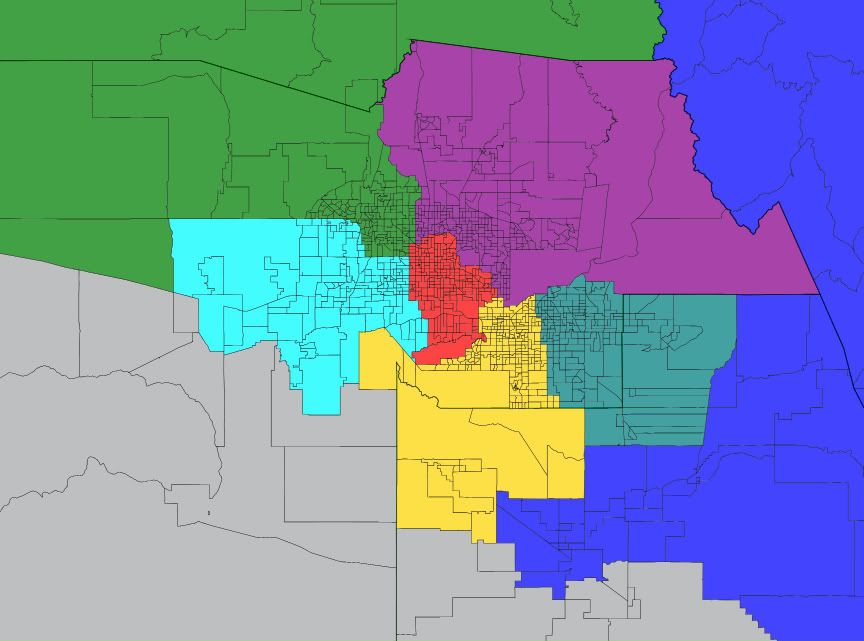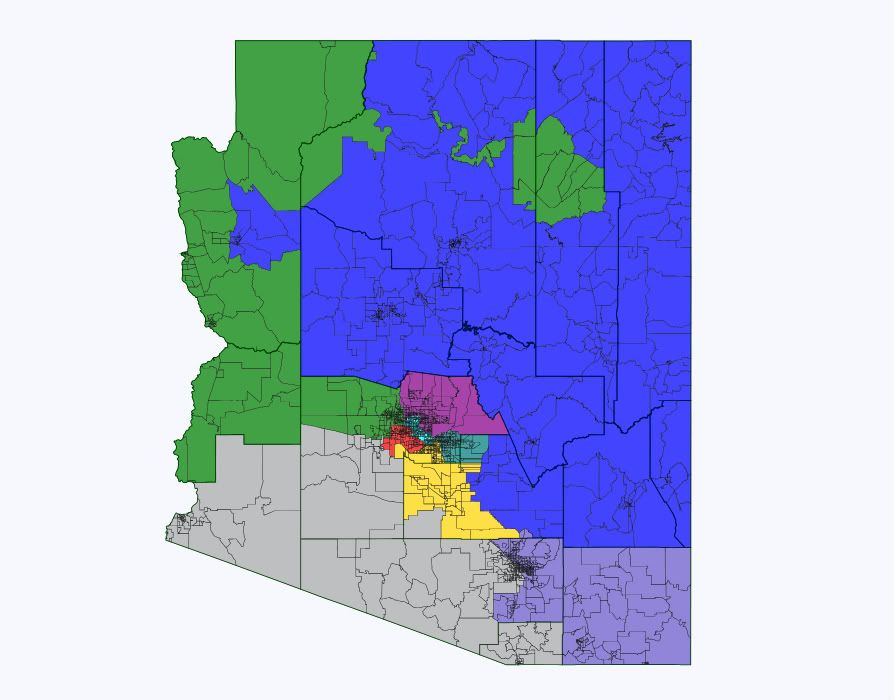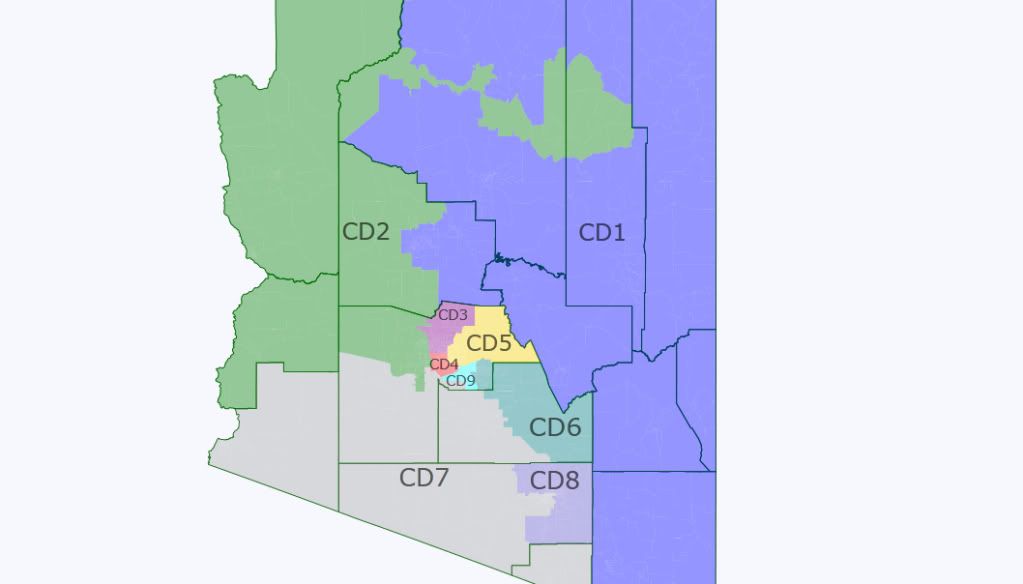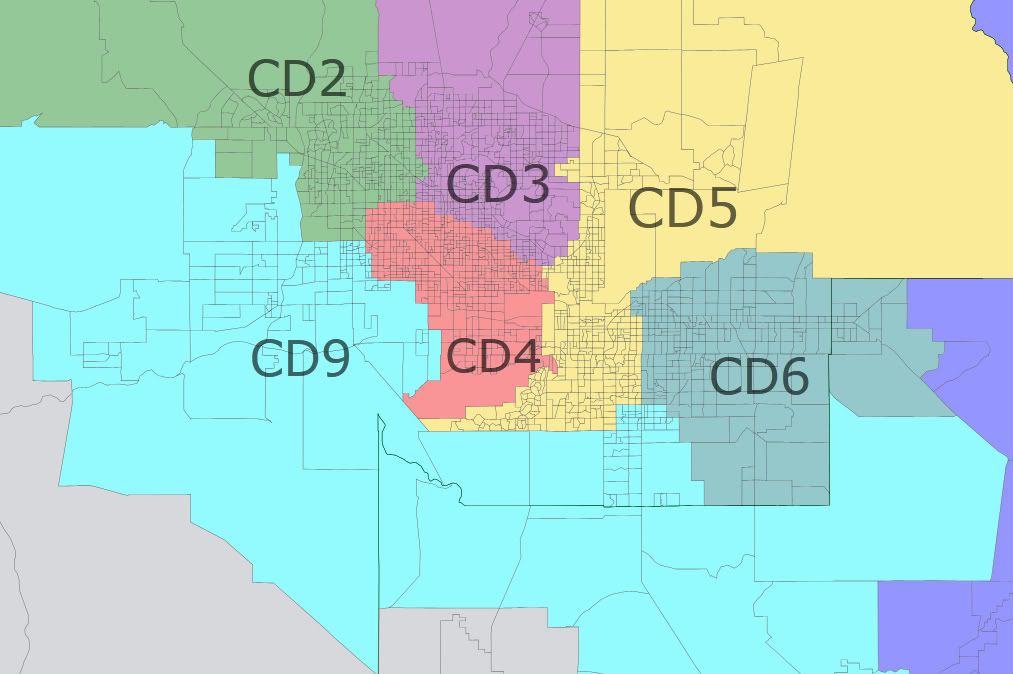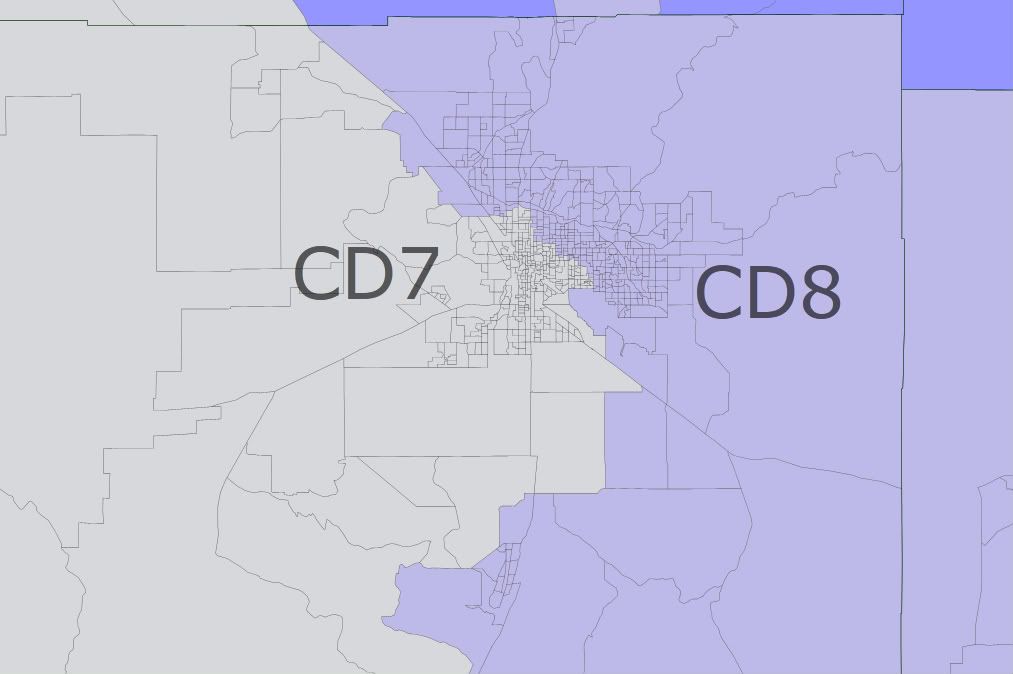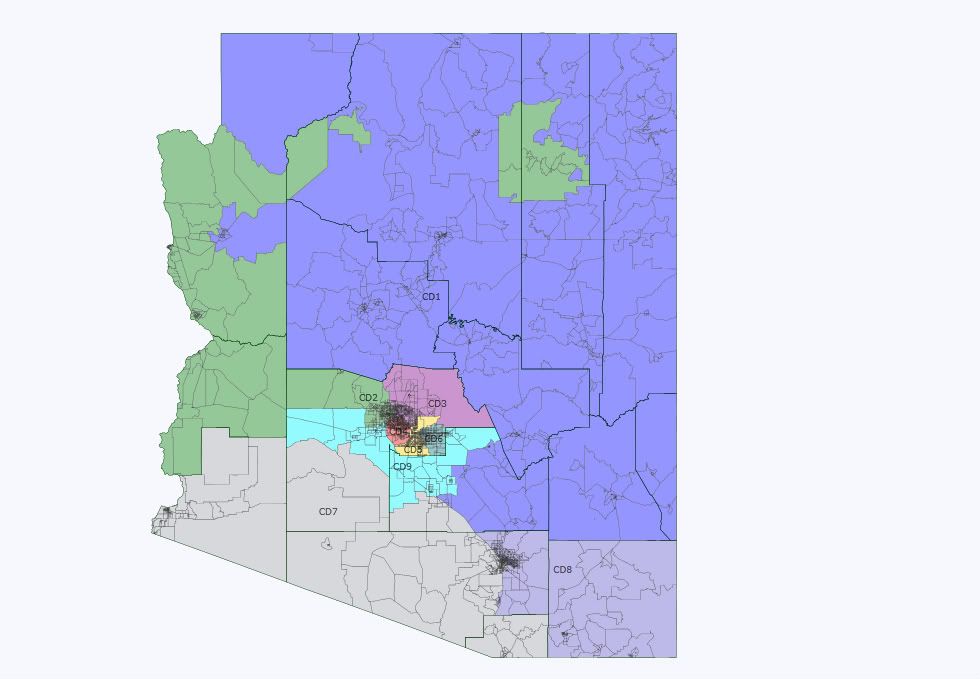Cross posted on my blog http://frogandturtle.blogspot…. which you should visit for more redistricting maps and election analysis.
Some states such as California have districts that almost never switch parties. In 2006-2010 though, Arizona’s House seats kept switching parties with 6 party switches throughout those years. Before 2006, Arizona had a 6-2 Republican map and after the 2008 elections, it was 5-3 Democratic. After 2010 though, the Republican tide hit here and the delegation shifted to 5-3 Republican. Arizona’s 7th and 8th Congressional District in 2010 also were close to switching parties although Raul Griljava (D) and Gabrielle Giffords (D) held their respective seats. Why was Arizona filled with competitive districts? They had an independent commission that drew the maps. Although Republicans hold the trifecta by holding the State Legislature and the Governorship, they have no power over redistricting because the commission draws the lines. I drew this map predicting what the commission will draw. Although a few of the districts such as the 5th and the 1st are competitive, I assume that this map will be a 5-4 Republican map. This is fair for Arizona because 5-4 Republican is similar to the partisan makeup of Arizona which leans Republican in most elections. I also strengthened many of the incumbents in this map such as Raul Griljava (D) and Gabrielle Giffords (D). My map has 1 Safe Democratic, 2 Likely Democratic, 1 Lean Democratic, 2 Lean Republican, and 3 Safe Republican seats. Anyway, here are the maps:
Here is a link to Arizona’s current map: http://www.nationalatlas.gov/p…
Also, click the maps if you want the full image
North Arizona
South Arizona
Arizona’s 1st Congressional District Paul Gosar (R) Blue
Partisan Data: McCain (estimated) 55%
Demographics: 19.2% Native American, 17.1% Hispanic, 59.5% White
Demographics 18+: 16.7% Native American, 14.6% Hispanic, 64.7% White
Old Demographics: 22.4% Native American, 16.4% Hispanic, 58.4% White
Communities: Flagstaff, Prescott, Sierra Vista
Status: Lean Republican
The 1st district does not undergo major changes as it loses Florence and Coolridge in Pinal County. The 1st district picks up all of Cochise County from the 8th district. Cochise County voted 59% for McCain and has large numbers of military members. It also helps make the district more Republican. The 1st district also loses part of Republican Gila County. Although these changes probably make Gosar’s district a point more Republican, he can still face a tough race. Ann Kirkpatrick (D), the former representative of the 1st district may run. She was one of the few Democrats in a district McCain won to vote against both the Stupak Amendment and the Affordable Care Act. She lost by 6 points which is not a nail biter but narrower than expected. A possibility though is that a Native American candidate may challenge her in the primary. A possible candidate is openly gay Navajo State Senator Jack Jackson (D) who almost ran for the 1st congressional district in 2006. On the other hand, Kirkpatrick has support with the Navajo Community because she received endorsements in 2010 from many Navajo leaders including Dr. Peterson Zeh, the Navajo Nation President in 2010. This may encourage Navajos, the largest Native American tribe in the 1st district to support Kirkpatrick instead of supporting a Navajo politician for the seat.
Arizona’s 2nd Congressional District Trent Franks (R) Green
Partisan Data: McCain (estimated) 62%
Demographics: 17.6% Hispanic, 72.6% White
Demographics 18+: 14.1% Hispanic, 77.3% White
Old Demographics: 14.2% Hispanic, 78.4% White
Communities: Lake Havasu City, Surprise, Peoria
Status: Safe Republican
The 2nd district undergoes a few changes. It gains conservative La Paz County from the 7th district and keeps the string to the Hopi Reservation intact. The lines there may look convoluted but the Hopi do not want to be represented in the same district as the Navajo so the 2nd district represents them. The 2nd district also retains western Maricopa County which is one of the fastest growing areas in the state. Surprise had 39,000 people in 2000 but has 117,000 today. Most of these newcomers are Republicans and the 2nd becomes more Republican as it loses some Hispanic precincts in Glendale. Franks should have no problems winning reelection in this conservative district.
Arizona’s 3rd Congressional District Ben Quayle (R) Purple
Partisan Data: McCain (estimated) 55%
Demographics: 19.2% Hispanic, 70.4% White
Demographics 18+: 15.8% Hispanic, 74.6% White
Old Demographics: 14.1% Hispanic, 78.5% White
Communities: Phoenix, Glendale, Paradise
Status: Lean Republican
The 3rd district becomes a point more Democratic as it loses Republican areas in northern Maricopa County such as Cave Creek and Carefree. The 3rd district gains a few Hispanic precincts in Glendale but retains its center in northern Phoenix. Although Quayle won by 11 points in 2010, it was a Republican year and his district is growing more Democratic. Also, Quayle is very conservative and ran an ad saying “Obama was the worst president ever” so his far right views could hurt him against a moderate Democrat in a Democratic year. Jon Hulburd (D) who challenged Quayle last year could run again in 2012 when Obama will probably contest Arizona.
Arizona’s 4th Congressional District Ed Pastor (D) Red
Partisan Data: Obama (estimated) 65%
Demographics: 8.1% African American, 59.8% Hispanic, 26.0% White
Demographics 18+: 8.3% African American, 53.2% Hispanic, 32.2% White
Old Demographics: 7.5% African American, 58.0% Hispanic, 29.3% White
Communities: Phoenix
Status: Safe Democratic
The 4th district’s lines stay extremely similar to the current ones but there are a couple of changes. The 4th district picks up a few Hispanic precincts from the 3rd district near the intersection of Northern Ave. and Route 17. The 4th also gives a few heavily Hispanic precincts on the eastern Phoenix border to the 5th district in order to make the 5th district more winnable for a Democrat. Besides these minor changes, the 4th district’s lines stay extremely similar to their current form. The district remains heavily Hispanic and Democratic.
Arizona’s 5th Congressional District Dave Schweikert (R) Yellow
Partisan Data: Obama (estimated) 52%
Demographics: 5.1% African American, 4.5% Asian, 30.2% Hispanic, 55.2% White
Demographics 18+: 4.9% African American, 4.7% Asian, 25.2% Hispanic, 61.2% White
Old Demographics: 2.7% African American, 3.3% Asian, 13.3% Hispanic, 76.8% White
Communities : Scottsdale, Tempe, Mesa
Status: Lean Democratic
This district undergoes major changes and becomes more Democratic as it loses conservative northern Scottsdale. To compensate for losing northern Scottsdale, the 5th district gains Hispanic neighborhoods in Mesa, Chandler and Phoenix. The less Hispanic parts of Mesa and Chandler are in the conservative 6th district. These changes bring the district’s Hispanic population up to 29% and the 18+ population to 24%. With the addition of the Hispanic areas, the district becomes more Democratic so Democrats have a stronger shot at winning here. Harry Mitchell (D), the district’s representative in 2010 will be 72 at the time of the 2012 election but he may run. If he does not, possible candidates include his son Mark Mitchell (D), the Vice Mayor of Tempe. Arizona Senate Minority Leader Dave Schapira (D) also from Tempe could run here too.
Arizona’s 6th Congressional District Jeff Flake (R) Teal
Partisan Data: McCain (estimated) 64%
Demographics: 14.7% Hispanic, 75.1% White
Demographics 18+: 12.1% Hispanic, 78.8% White
Old Demographics: 17.2% Hispanic, 76.6% White
Communities: Apache Junction, Gilbert, Mesa
Status: Safe Republican
The area around Mesa and Apache Junction is one of the fastest growing areas in the nation so the 6th district had to shed population. It grew more Republican as well because it lost western Chandler and western Mesa, both swing areas with a growing Hispanic population. The 6th district also gained the Gila River Indian Reservation which is Democratic but should not alter the political leanings of the 6th district much. Although this district is too conservative to elect a Democrat, the Republicans could face a bruising primary if Jeff Flake (R) retires to run for Senate. The Republican bench is large here and potential candidates include State Senator Thayer Veschoor (R), State Senator Chuck Grey (R), Mesa Mayor Scott Smith (R) or Superintendent of Public Instruction John Huppenthal (R). If Huppenthal ran, he would probably win the primary due to his power as the former Senate Majority Leader but he may want to remain the Superintendent of Public Instruction. Anyway, unless a powerful candidate such as Huppenthal ran who can clear the field, the 6th district will face a large primary.
Arizona’s 7th Congressional District Raul Griljava (D) Gray
Obama (estimated) 59%
Demographics: 58.0% Hispanic, 4.0% African American, 31.7% White
Demographics 18+: 52.6% Hispanic, 4.0% African American, 37.5% White
Old Demographics: 2.8% African American, 50.6% Hispanic, 38.6% White
Communities: Phoenix, Yuma, Tucson
Status: Likely Democratic
Griljava won by 6 points in a closer than expected race against teabagger Ruth McClung (R) despite his district’s high Hispanic population. I made some changes to his district in order to strengthen him. Also, his district’s current Hispanic 18+ population is below 50% so making Griljava’s district more Hispanic helps boost the Hispanic 18+ population above 50%. It is important to keep the Hispanic 18+ population above 50% because the VRA requires that some districts be not only minority majority but have an 18+ population above 50% too.
Arizona’s 8th Congressional District Gabrielle Giffords (D) slate blue
Partisan Data: Obama (estimated) 50%
Demographics: 29.2% Hispanic, 60.8% White
Demographics 18+: 24.7% Hispanic, 65.9% White
Old Demographics: 18.2% Hispanic, 73.9% White
Communities: Tucson, Oro Valley, Catalina
Status: Likely Democratic if Giffords runs, lean Democratic if not
First, I wish Giffords a full recovery from the Tucson shooting last January. If she recovers fully but decides not to return to politics, it is possible her husband Mark Kelly (D), one of the astronauts on the Endeavor will run in her place. Spouses of representatives often replace the representative when the representative is unable to run. Lois Capps (D) in Santa Barbara, Ca replaced Walter Capps (D), Mary Bono (R) replaced Sonny Bono (R) in Riverside County, Ca. Spouses are not always successful though as Stephanie Moore (D) learned when she unsuccessfully ran for her husband’s seat in Kansas. Anyway, if Giffords wants to return to politics, she can run for her House seat or Jon Kyls’ (R) open U.S Senate seat. Even if she does not run for the 8th district, the Democrat here will have a more favorable district. Giffords won last year by 4,000 votes and I removed all of Cochise County which she lost by 4,000 votes. I also removed all her district’s territory in Pinal County which she lost by 1,200 votes. If the election were held under her district’s current lines excluding Cochise and Pinal Counties, Giffords would win by 9,200 votes. Her district becomes even safer and more Tucson centered as it gains part of heavily Hispanic South Tucson from the 7th district and loses conservative areas near Picture Rocks. Although this is not a safely Democratic district, Tucson’s increased clout here will make it easier for Giffords or her replacement to win.
Arizona’s 9th Congressional District Vacant Cyan
Partisan Data: McCain (estimated) 58%
Demographics: 21.0% Hispanic, 69.1% White
Demographics 18+: 17.9% Hispanic, 72.9% White
Old Demographics: N/A
Communities: Scottsdale, Casa Grande, Marana
Status: Safe Republican
The lines on this map remove Republican areas from the 1st, 5th, 6th, 7th and 8th district and I combined those areas in the new 9th district. Those areas include northern Scottsdale in Maricopa County, all of Pinal County except for the Gila River reservation and Apache Junction, part of Gila County and Marana in Pima County. This district is too conservative for a Democrat to win but there could be a competitive Republican primary. Possible candidates could be State Senator Steve Smith (R) from Pinal County or State Senator Michelle Reagan (R) from Scottsdale.




















